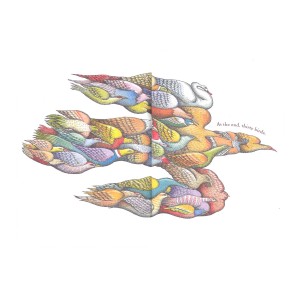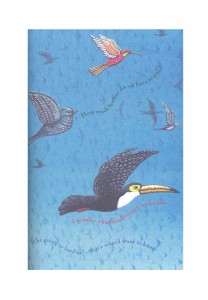Redrawing Persepolis
May 5th, 2012
My last project was inspired by a crossover between two weeks, week 10 (which focused on Conference of the Birds) and week 12 (in which we read Persepolis). I loved the story of the Conference of the Birds, and the format of Persepolis, but didn’t see a link between the two until I discovered a newly published book in Lamont. Written and illustrated by Peter Sis, it tells the story of the conference of the birds in a beautiful, reductionist way. A children’s illustrator, Sis focuses on sumptuous drawings that tell his story in a simple but understandable way. Though the format is technically for a child, the language and beauty of the images elevate it to something that an adult can enjoy as well—just like Persepolis’s layout. The translation does not illustrate all of the complexities of the original, but it narrate the story itself in a sparing but poetic way.
(From Sis, Peter. The Conference of the Birds. New York: Penguin Press, 2011.)
For my last project, I decided to try to translate some of Persepolis into the style of Sis. Stylistically—both in terms of the writing and in terms of the artwork—they differ very greatly, and I wanted to translate Persepolis from one style to the other.
I decided to center on the protagonist’s relationship with God, which I found the most touching part of the story. God appears only peripherally in her narrative, but is clearly an important character—I decided to give their relationship its own book, calling the book “A Love Story.” Though originally I ambitiously planned to tell the entire story, each with about a line of text on the page, I quickly realized (after numerous hours spent on just one page) that I would have to settle for just telling the first sentence of the story. The following image is therefore just the introduction to the story—if I have time, I would love to go finish her story.
Though this doesn’t appear in the abbreviated product I ended up creating, it did initially bother me that in translating formats, I would completely depoliticize a book that was clearly meant to be political. I do think that political or not, any work that highlights the love and power that threads through Persepolis has in some way done the original work justice.
The final image is that of a young girl lying in a field. The caption reads, “Once upon a time there lived a girl that loved God.” The colors are super-saturated, as in Sis’s work, and the style is clearly not meant to be realistic but neither is it cartoonish.



